I have always been an avid runner. When I was 11, my dad coached my track and cross-country teams, and—other than my six month recovery from hip surgery that took place in April 2014—I haven’t gone a full two weeks without running since then. It’s always been part of my identity. Therefore, the category I chose to concentrate on was…
Category
Activity, All the Way!
Since having surgery to repair a torn labrum, my hip aches when I get overzealous and attempt longer runs like I used to do in the past, which is why I’ve recently taken up going to spin class to stay active on days when my hip doesn’t want to let me run. On the first day of spin, I set everything up to the proper heights (seat, handlebars, etc.), got on my bike, and started pedaling, but the first thing out of the instructor’s mouth was, “Ok now everyone check those heart rates! Increase your resistance if you are not in your ‘cardio’ zone!” Shoot. How was I supposed to know what heart rate zone I was in? I thought I just had to bring myself to class, get on a bike, and follow the instructor’s lead… now I’m supposed to have a heart rate monitor?
Thankfully, that week, a Fuzzy Math colleague (Julia) informed me about our Wearables project, and that I should begin researching which wearable device to test out. She said to choose one that I would actually want to own, and I immediately began researching wearable devices that monitored heart rate. It was also important to me to have a device that tracked and displayed the distance I’ve run, for both jog-logging reasons as well as safety reasons (hey, a girl’s gotta take every precaution she can when running alone). Then I was told to pick a group, so because my main focus for choosing a wearable was to monitor my heart rate and running stats, I chose the activity group.
The Decision
When it came down to the wire and I had to decide on which device to buy, I was heart-wrenchingly torn between the Jawbone UP3 and the Fitbit Charge HR. Both devices monitored heart rate using pulse sensors hidden inside the band; both devices had food tracking to help you monitor how many calories you eat each day (which comes in handy since I’m a snacker); and both devices tracked sleep patterns, which I found interesting even though that’s not my focus. The Jawbone UP3 is much cuter and could blend in as a stylish bracelet, whereas the Fitbit Charge HR looks more like a tracking device prisoners wear when they’re on house arrest (okay, that’s a bit dramatic I suppose). Ultimately, I went with the Fitbit Charge HR despite its fashionable shortcomings for one specific reason: I could view my heart rate at any time during spin class by simply double tapping the screen. The Jawbone UP3 would have required me to keep my phone balanced on my handlebars during class and open the app any time the instructor called out a new heart rate zone to maintain. No thanks.
User Friendliness
The day I went to REI and purchased my Fitbit Charge HR was an exciting one. Just look at it in all its glory:
The box itself was not remarkably user-friendly (too much glue?), or maybe the user was too friendly to the box…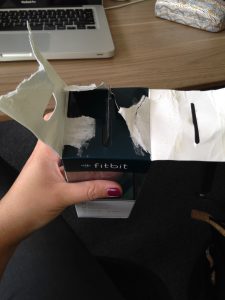
Either way, once I got it open and hooked it up to charge, the magic began. Well, sort of. Let me rephrase: once I got it open, I was instructed to plug the “wireless sync dongle” into my laptop, which triggered a software download that prompted me to register my Fitbit. After I registered, my laptop screen displayed four empty boxes and asked me to enter the code on the display of my Charge HR. Well, there was no code, so I reinstalled the software thinking it would wirelessly sync with the device and perhaps trigger the code to pop up on the second try (I did have the wireless sync dongle plugged in after all). Nope, that didn’t work either. At that point, I was unsure about what to do next. Was I supposed to let my new device charge all the way before setting it up? If so, how long would that take? Was I supposed to push the button to make the code appear? No, that didn’t work… hold the button? Yep. There we go. It would’ve been helpful to have been provided with a step-by-step guide detailing each miniscule step in the setup process, regardless of how self-explanatory the people at Fitbit thought it would be for users.
Once I got the app running on my laptop, it was super  easy to set everything up. I was able to customize certain settings such as the order in which my stats were displayed, which hand was my dominant hand, how I wanted to receive notifications, which of my contacts I wanted to be Fitbit friends with, privacy (who can see my stats), and even silent alarms (yes, you can set multiple alarms!). The button on the side even makes it ridiculously easy to track a workout without having to open the app on your phone—you simply hold down the button for a couple seconds and it kicks off a timer, and when you’re finished working out, just hold the button again to stop the timer. I love that it judges me as soon as I finish a workout, too, as it did after this jog.
easy to set everything up. I was able to customize certain settings such as the order in which my stats were displayed, which hand was my dominant hand, how I wanted to receive notifications, which of my contacts I wanted to be Fitbit friends with, privacy (who can see my stats), and even silent alarms (yes, you can set multiple alarms!). The button on the side even makes it ridiculously easy to track a workout without having to open the app on your phone—you simply hold down the button for a couple seconds and it kicks off a timer, and when you’re finished working out, just hold the button again to stop the timer. I love that it judges me as soon as I finish a workout, too, as it did after this jog.
Design/Comfort
When I was researching the Fitbit Charge HR, I found that there were numerous complaints about how uncomfortable the band could be. I even saw some scary pictures of people’s red, irritated, blistered, looked-like-Indian-sunburn wrists. By that point, though, I had already made my decision to purchase this over any other heart rate monitoring wearables and figured I could either tough it out or return it if it was unbearable. What I’ve found, though, is that I have had very little—if any—skin irritation. For me, the issue was more that my wrists weren’t flat enough, so I endured about a week of what I refer to as a wrist-flattening process (it just felt like I had a watch sitting on a bruise), but now that that’s over with, I don’t even notice it’s there anymore! Occasionally when I’m running, I’m reminded I’m wearing it because sweat will drip profusely up/down my arm, originating from the rubber wristband. That’s about it.
Difficulties
I can’t explain why, but the first month of wearing my new Fitbit Charge HR, I experienced a few technical difficulties. The first one happened after only wearing it for two days: the side button wouldn’t turn the screen on, although the app on my laptop was showing that it had plenty of battery left. Then, a week(ish) later, my Charge HR wasn’t responding to taps or button presses. Finally, a week after that, I received a phone call (which triggers the device to vibrate and display the caller ID info) and the device continued to vibrate even after I had answered the call. The screen went a little crazy, too! Luckily, Fitbit has a thoroughly written support page. I looked up troubleshooting tips here after the very first incident and found that all I had to do in any circumstance when errors like these occurred was to plug the Fitbit into the charger and hold the button on the side for about 10 seconds, then when the screen resets, unplug it. It worked like a charm each time, but I’m hoping I won’t have to continue doing that in the future.
Another difficulty was the level of inaccuracy I noticed during my first week of wearing this device. I’m left-handed, so naturally, I put my Charge HR on my right wrist (people wear their watches on the hand opposite that with which they write normally, right?). I noticed one time when I had my app opened while getting ready to go out that my step count was increasing remarkably while I blew my hair dry and brushed my teeth. It was then when I realized that even though I eat and write lefty, I do pretty much everything else as a righty, so I went into my settings and switched my Fitbit hand to “dominant.” After that, it wasn’t nearly as sensitive to my every movement, and the step count seemed much more accurate.
Lastly, I have noticed that my device doesn’t count steps when I’m holding a shopping basket or pushing a cart, yet it sometimes counts arm movements when I’m cooking dinner as steps. It also only catches very few steps when I walk around with my hands over my head after a run. Part of me wishes there were some way to tell it, “Keep counting subtle movements now—I’m still working out,” while not allowing it to count subtle movements when I’m playing with my cat or stirring pasta sauce. Fitbit realizes that discrepancies may occur between actual steps and logged steps, as they wrote on their support site, “Don’t forget, it’s the trends that matter the most in achieving your health and fitness goals.”
Battery
The battery on this is great. First, when plugged into the charger, the screen displays a picture of a battery and fills it with lines depending on how charged the device is. It usually lasts around five days, give or take, and the app provides approximately one day’s warning before the battery dies. I’ve learned that when the app has continuous sync turned on, the battery dies much faster than when the app is on manual sync.
Charging is simple, too—just connect the cord from a USB outlet into the device and let it sit. It usually takes about two hours to go from completely dead to completely charged.
Screen/Interface
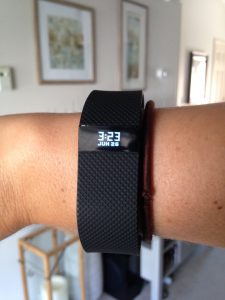 While the screen on my Fitbit Charge HR can be a little bit difficult to activate by tapping, there are a handful of things I absolutely love about it. First, you can have a custom clock displayed by selecting one of four options available in the dashboard. This is the one I chose (I like that it shows both date and time):
While the screen on my Fitbit Charge HR can be a little bit difficult to activate by tapping, there are a handful of things I absolutely love about it. First, you can have a custom clock displayed by selecting one of four options available in the dashboard. This is the one I chose (I like that it shows both date and time):
Also, the heart rate screen is fantastic! When at rest, there’s an outline of a heart that beats alongside a number showing your current heart rate. During workouts (or if for some other reason your heart rate is markedly elevated), the heart rate display will show a solid/filled heart icon in one of three positions: below two lines, sitting on the middle line, or above two lines. The position of the heart on the three lines tells you whether your heart is beating in one of three zones: fat burn, cardio, or peak (respectively). This is super helpful when I’m at spin class and the instructor shouts, “I want you all in that peak zone within the next thirty seconds!” …which leads me to another aspect I love about the screen…
You can fully customize the content that appears on it and the order in which each item is displayed when you click the button on the side. On mine, I set the clock/date to appear first (since I can never remember the date), and the heart rate screen second, then steps, 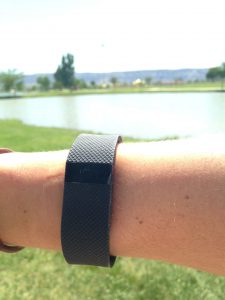 calories, and floors climbed after that, even though I don’t care about any of those numbers as much. What’s also neat with this level of customization is that you can set which screen you want to appear first when you double tap it (this can be different than the screen you set to appear first when you press the side button). For this, I chose the heart rate screen so when I’m struggling to stay on my spin bike, all I have to do is a quick double tap and voila! There’s my BPM and I can tell which zone I’m working in.
calories, and floors climbed after that, even though I don’t care about any of those numbers as much. What’s also neat with this level of customization is that you can set which screen you want to appear first when you double tap it (this can be different than the screen you set to appear first when you press the side button). For this, I chose the heart rate screen so when I’m struggling to stay on my spin bike, all I have to do is a quick double tap and voila! There’s my BPM and I can tell which zone I’m working in.
The only true drawback with the screen is that it can be tough to read under bright sunlight (as pictured above).
The App
I have a love/want-to-love-more relationship with the Fitbit app. There’s honestly nothing about it that I hate; I just wish some aspects of it were made better. I’ll start with those so we can finish this on a high note.
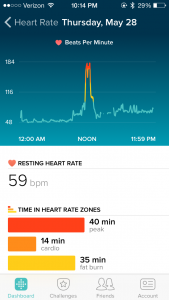 The “meh” list:
The “meh” list:
I want there to be more detail with the heart rate statistics I get. Actually, I almost feel bad putting this on the “meh” list since what the app does give you is so detailed (I just want it to be even more detailed). On this screen, I’d like to be able to hover over any part of the screen and see what time it was and what my exact heart rate was at that time. Since the 24 hours of a day are condensed to the width of the screen, it’s difficult to know at what point in my workout I experienced a dip in heart rate from peak to cardio, and to what number in the cardio zone did it dip? Knowing this information would help me piece together my workouts and help me improve them based on recalling what I did that lowered the effectiveness of previous workouts.
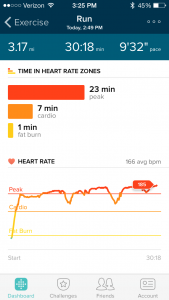 On this next screen (which I should add did not come from the same workout as the screen above), I’d like to know at what times during my run did I cross over the lines that separate fat burn, cardio, and peak heart rates. While it’s interesting to see from the data that my heart rate could only go so high before my body told me to slow down (hence my heart rate dropping back down to cardio), I would still like to know how many minutes I was able to last during each segment before slowing down. Again, perhaps being able to hover over the heart rate line and have a time (minutes:seconds) appear, I’d be satisfied.
On this next screen (which I should add did not come from the same workout as the screen above), I’d like to know at what times during my run did I cross over the lines that separate fat burn, cardio, and peak heart rates. While it’s interesting to see from the data that my heart rate could only go so high before my body told me to slow down (hence my heart rate dropping back down to cardio), I would still like to know how many minutes I was able to last during each segment before slowing down. Again, perhaps being able to hover over the heart rate line and have a time (minutes:seconds) appear, I’d be satisfied.
My last “meh” item is the food logging. I wish the Fitbit app contained a more robust database of food brands to make logging my daily intake easier. I believe most (or all?) chain restaurants are required to provide calories per menu item (and Fitbit seems to have all of this information), but when it comes to grocery store brands, this isn’t so much the case. I tend to find myself examining the labels of certain products I buy and manually entering in the data so it’s available for the next time I enter it. What kills me, though, is entering meals I’ve cooked. I’m not Italian at all, but I’ve been told I cook like one. Everything I add is “to taste,” which means I never, never measure what I put into meals. Plus, I’m not going to stand there and enter each ingredient into my Fitbit when I cook — “ain’t nobody got time for that!”
The “LOVE!” list:
GPS tracking!
Even though my Fitbit device itself doesn’t have built-in GPS, if I have my phone on me and have GPS enabled, the app syncs with MobileRun to show my exact location as I’m running. This was an unexpected bonus because I knew when I purchased the Fitbit Charge HR that it didn’t come with GPS tracking in the device. It’s important to me because I tend to do more down-and-back runs than I do loop runs; so if I want to run four miles, I’d need to see exactly when I hit the two mile mark so I know when to turn around. Also (I hope nobody thinks this is too strange… I might’ve watched too many Lifetime movies with my mom when I was younger), I have this weird fear that someone’s going to throw me in the trunk of their car and drive away, so I feel a little more secure when I know GPS is tracking my location when I go out for a run.
Another thing I love: estimated calorie burn that’s actually (probably, hopefully) accurate! If only I were better at entering food into that log, my “calories left” would be accurate, too. Thankfully, calorie burn and calories left are two different things. While calories left are dependent upon calories eaten and calories burned, calorie burn is only dependent upon one’s size (height and weight) and various heart rate measurements throughout the day. Even though knowing how many calories I burned from an activity doesn’t provide my full fitness story, it is exciting to see which activities result in greater calorie burn (e.g. running three miles at a constant pace versus run/walking five miles in speed intervals).
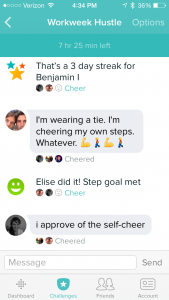 Love the social aspect: challenges! The Fitbit app makes it fun to go places—whether you’re walking around TJ Maxx, hiking, or simply going to work. For me, since I work remotely, “going to work” usually results in fifteen steps (and that’s being generous). Despite the fact that I always come in last—guaranteed!— because all my coworkers who participate in challenges with me live in or near Chicago and walk to and from trains and buses, I still very much enjoy participating. The Fitbit app makes it fun because you can “cheer” or “taunt” people, and you can also have a group chat that takes place within each challenge. Fitbit also throws in some of its own fun commentary, such as what’s pictured to the right.
Love the social aspect: challenges! The Fitbit app makes it fun to go places—whether you’re walking around TJ Maxx, hiking, or simply going to work. For me, since I work remotely, “going to work” usually results in fifteen steps (and that’s being generous). Despite the fact that I always come in last—guaranteed!— because all my coworkers who participate in challenges with me live in or near Chicago and walk to and from trains and buses, I still very much enjoy participating. The Fitbit app makes it fun because you can “cheer” or “taunt” people, and you can also have a group chat that takes place within each challenge. Fitbit also throws in some of its own fun commentary, such as what’s pictured to the right.
I do think it would be fun to be able to send pictures in this group chat, as well as “taunt” people in it (currently you can only taunt people by visiting their individual profiles). I wouldn’t do it to be mean—just for fun.
Is it Matching Expectations?
Despite the very small drawbacks I had within the first few weeks of owning my Fitbit Charge HR, and a couple small things I’d improve in the app, I am highly satisfied with it overall. I think that with a few tweaks and updates, it could be the best fitness device there is.